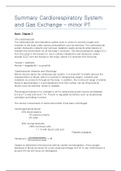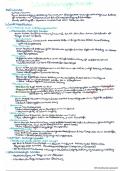Summary Cardiorespiratory System
and Gas Exchange – minor PT
Book: Chapter 2
The cardiovascular
The cardiovascular and respiratory system work in unison to provide oxygen and
nutrients to the body under various perturbations such as exercise. The cardiovascular
system transports nutrients and removes metabolic waste products while helping to
maintain the environment for all the body’s functions. The blood transports oxygen (O 2)
from the lungs to the tissues for use in cellular metabolism and transports carbon
dioxide (CO2) form the tissues to the lungs, where it is removed from the body.
Tissues > weefsels.
Arterial > slagaderlijk > zuurstofrijk
Cardiovascular Anatomy and Physiology
Before discuss about the cardiovascular system, it is important to briefly discuss the
characteristics of blood, which is involved in transporting oxygen, nutrients and
metabolic by products throughout the body. In addition, the normal pH range of arterial
blood is approximately 7.4 and deviations from this number can be influenced by
factors such as exercise, stress or disease.
Physiological tolerance for changes in pH for arterial blood and muscle are between
6.9 and 7.5 and 6.63 and 7.10. The pH is regulated by buffers such as bicarbonate,
ventilation and kidney function.
The various components of whole blood after it has been centrifuged.
Centrifuged whole blood:
55% blood plasma
7% plasma proteins
3% other
45% formed elements
>99% red blood cells
< 1 % with blood cells and
Platelets (plaatjes).
45% formed elements
Hematocrit: 100% total blood volume
= 45
Oxygen is dissolved in the blood as well as carried via hemoglobin. Since oxygen
dissolved in blood accounts for a very small percentage (0.3 ml O2 per 100ml blood or
around 2%) we will focus on hemoglobin.
, Hemoglobin is an iron containing (bevattende) protein within the red blood cells that
has the capacity to bind between one and four oxygen molecules. Each gram of
hemoglobin, therefore, can carry approximately 1.39 ml of oxygen.
1 gram hemoglobin > 1.39 ml O2
Healthy blood has approximately 15 g of hemoglobin > per 100 ml
That means, the capacity of healthy blood to carry oxygen approximate 20.8 ml of
oxygen per 100 ml blood:
(1.39 ml O2) x (15 g of hemoglobin) = 20.8 ml O2 per 100 ml of blood
Oxygen-Hemoglobin Dissociation Curve
This curve illustrates the saturation of hemoglobin at various partial pressures. Partial
(gedeeltelijk) pressure is essentially the pressure exerted by one gas in a mixture of
gasses and is calculated as the product of total pressure of a gas mixture and the
percent concentration of the specific gas.
For example
Normal atmospheric pressure > 760 mmHg
Partial pressure > 159 mmHg
Percent concentration of oxygen in the atmosphere > 20.93%
> 760mmHg x 0,2093 = 159mmHg
As shown in figure 2.2 (blz. 18), the relationship between partial pressure of oxygen
and oxygen saturation is sigmoidal (S-shaped) as opposed to linear (direct).
Factors Influencing the Oxygen-Hemoglobin Curve
Thus shifting the curve to the right or left (for example, a decrease in core body
temperature results in shifting the curve toward the left, whereas an increase in
temperature results a shifting the curve toward the right.
Arterial blood acidity (zuurheid) (for example, blood with low pH (acidic) results
the curve shifting right, whereas blood with high pH (alkalosis) results in the
curve shifting left.
Exercise, typically because the core body temperature will increase.
>pH = zuur = acidic
<pH = niet zuur = alkalosis
Cardiac Morphology
The heart is composed of cardiac muscle, which unlike skeletal muscle is
mononucleated, contains four chambers:
Right atrium
Left atrium
Right ventricle
Left ventricle
and Gas Exchange – minor PT
Book: Chapter 2
The cardiovascular
The cardiovascular and respiratory system work in unison to provide oxygen and
nutrients to the body under various perturbations such as exercise. The cardiovascular
system transports nutrients and removes metabolic waste products while helping to
maintain the environment for all the body’s functions. The blood transports oxygen (O 2)
from the lungs to the tissues for use in cellular metabolism and transports carbon
dioxide (CO2) form the tissues to the lungs, where it is removed from the body.
Tissues > weefsels.
Arterial > slagaderlijk > zuurstofrijk
Cardiovascular Anatomy and Physiology
Before discuss about the cardiovascular system, it is important to briefly discuss the
characteristics of blood, which is involved in transporting oxygen, nutrients and
metabolic by products throughout the body. In addition, the normal pH range of arterial
blood is approximately 7.4 and deviations from this number can be influenced by
factors such as exercise, stress or disease.
Physiological tolerance for changes in pH for arterial blood and muscle are between
6.9 and 7.5 and 6.63 and 7.10. The pH is regulated by buffers such as bicarbonate,
ventilation and kidney function.
The various components of whole blood after it has been centrifuged.
Centrifuged whole blood:
55% blood plasma
7% plasma proteins
3% other
45% formed elements
>99% red blood cells
< 1 % with blood cells and
Platelets (plaatjes).
45% formed elements
Hematocrit: 100% total blood volume
= 45
Oxygen is dissolved in the blood as well as carried via hemoglobin. Since oxygen
dissolved in blood accounts for a very small percentage (0.3 ml O2 per 100ml blood or
around 2%) we will focus on hemoglobin.
, Hemoglobin is an iron containing (bevattende) protein within the red blood cells that
has the capacity to bind between one and four oxygen molecules. Each gram of
hemoglobin, therefore, can carry approximately 1.39 ml of oxygen.
1 gram hemoglobin > 1.39 ml O2
Healthy blood has approximately 15 g of hemoglobin > per 100 ml
That means, the capacity of healthy blood to carry oxygen approximate 20.8 ml of
oxygen per 100 ml blood:
(1.39 ml O2) x (15 g of hemoglobin) = 20.8 ml O2 per 100 ml of blood
Oxygen-Hemoglobin Dissociation Curve
This curve illustrates the saturation of hemoglobin at various partial pressures. Partial
(gedeeltelijk) pressure is essentially the pressure exerted by one gas in a mixture of
gasses and is calculated as the product of total pressure of a gas mixture and the
percent concentration of the specific gas.
For example
Normal atmospheric pressure > 760 mmHg
Partial pressure > 159 mmHg
Percent concentration of oxygen in the atmosphere > 20.93%
> 760mmHg x 0,2093 = 159mmHg
As shown in figure 2.2 (blz. 18), the relationship between partial pressure of oxygen
and oxygen saturation is sigmoidal (S-shaped) as opposed to linear (direct).
Factors Influencing the Oxygen-Hemoglobin Curve
Thus shifting the curve to the right or left (for example, a decrease in core body
temperature results in shifting the curve toward the left, whereas an increase in
temperature results a shifting the curve toward the right.
Arterial blood acidity (zuurheid) (for example, blood with low pH (acidic) results
the curve shifting right, whereas blood with high pH (alkalosis) results in the
curve shifting left.
Exercise, typically because the core body temperature will increase.
>pH = zuur = acidic
<pH = niet zuur = alkalosis
Cardiac Morphology
The heart is composed of cardiac muscle, which unlike skeletal muscle is
mononucleated, contains four chambers:
Right atrium
Left atrium
Right ventricle
Left ventricle












